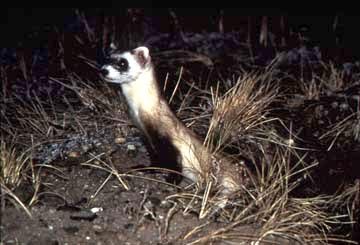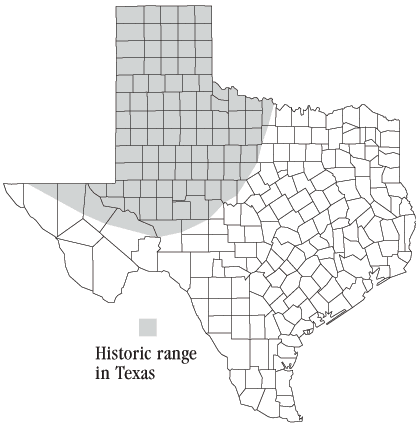Black-footed Ferret (Mustela nigripes)

TPWD ©
- Texas Status
- Endangered
- U.S. Status
- Endangered, Listed 3/11/1967
- Description
- The Black-footed Ferret has a long, slender body with short legs. Its fur is a light brown color, with dark brown or black legs and feet and a black-tipped tail. Its face is distinctively marked with white fur and a black, raccoon-like mask.
- Life History
- Black-footed Ferrets rely on prairie dogs for food and shelter. Prairie dogs make up 90% of their diet. Scientists estimate that over 100 million acres of western rangelands were occupied by prairie dogs in the early 1900's. Much of this area was also occupied by Black-footed Ferrets. Ferrets hunt mostly at night, so they are rarely seen. They live in burrows made by prairie dogs. It takes about 100 acres of prairie dog colony to support one ferret family (a female and her young). Predators such as owls, eagles, hawks, Coyotes, badgers, foxes, and Bobcats are the main cause of death for wild ferrets.
Black-footed Ferrets are endangered because much of the shortgrass prairie habitat on which the ferrets depend has been plowed for crops. Prairie dogs, which are the ferrets' main food, have been reduced in number due to habitat loss and disease. Prairie dogs have been killed because they eat grass used by livestock or winter wheat grown as a crop. - Habitat
- Shortgrass prairies are ideal habitat in which Black-footed Ferrets are found.
- Distribution
 Historically, the Black-footed Ferret occurred in the High Plains, Rolling Plains, and Trans-Pecos regions of North America. Black-footed Ferrets have not been seen in Texas since 1963; wild populations exist in Wyoming, South Dakota, and Montana.
Historically, the Black-footed Ferret occurred in the High Plains, Rolling Plains, and Trans-Pecos regions of North America. Black-footed Ferrets have not been seen in Texas since 1963; wild populations exist in Wyoming, South Dakota, and Montana.- Other
- Ferrets are susceptible to canine distemper, to which they have no natural immunity.
For more information
Additional details can be found in the online version of The Mammals of Texas for the Black-footed Ferret.